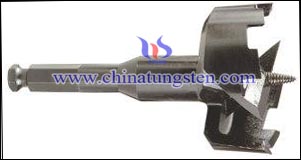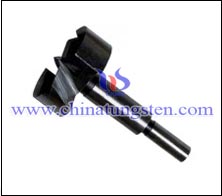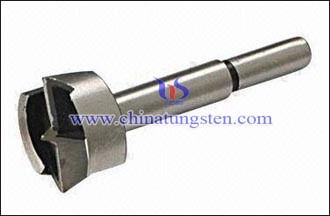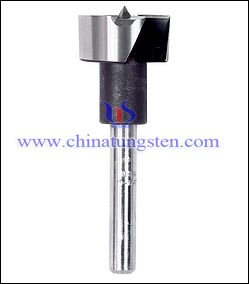Tungsten Carbide Forstner Bits Ⅶ
- Details
- Category: Tungsten Information
- Published on Wednesday, 25 November 2015 13:42
- Written by zhihua
- Hits: 357
In last part we know that tungsten carbide Forstner bits can only be used in a drill press, cannot remove chips automatically, are relative more expensive and difficult to sharpen. In this part we explain how to sharpen a Forstner bit.
Some woods, such as cedar, contain silicates that can gradually dull, albeit slower, the tungsten carbide Forstner bits. To sharpen a Forstner bit, we can follow the below steps:

(The End--This article is divided into several parts. Here is part 7. For part 6 please refer to http://news.chinatungsten.com/en/tungsten-information/80739-ti-10469)
| Tungsten Carbide Supplier: Chinatungsten Online tungsten-carbide.com.cn | Tel.: 86 592 5129696; Fax: 86 592 5129797;Email:sales@chinatungsten.com |
| Tungsten News&Tungsten Prices, 3G Version: http://3g.chinatungsten.com | Molybdenum News & Molybdenum Price: http://news.molybdenum.com.cn |
Tungsten Carbide Forstner Bits Ⅵ
- Details
- Category: Tungsten Information
- Published on Wednesday, 25 November 2015 13:39
- Written by zhihua
- Hits: 410
In last part we know that tungsten carbide drill bits have special cutting rims, which make them able to drill holes cleanly, more precisely, faster and better than other bits, and are multifunctional as well. In this part we explain the drawbacks and precautions to use a Forstner bit.
In most cases all tungsten carbide Forstner bits are intended for mounted drill presses rather than hand-held tools. They typically require a lot of force, which can be dangerous and sometimes even unwieldy on a smaller appliance.
So people who want to use it typically have to invest in a drill press, and even then they often have to have at least a bit of training in order to control and properly use it. The bits also tend to be somewhat difficult to sharpen, and they don’t have any way of blowing dust back out the way some bits do; what this means in practical terms is that carpenters may have to pause more often to clear the bores. These bits also tend to be a bit more expensive than their counterparts.

(To be continued. This article is divided into several parts. Here is part 6. For part 5 please refer to http://news.chinatungsten.com/en/tungsten-information/80738-ti-10466; for part 7 please refer to http://news.chinatungsten.com/en/tungsten-information/80740-ti-10470)
| Tungsten Carbide Supplier: Chinatungsten Online tungsten-carbide.com.cn | Tel.: 86 592 5129696; Fax: 86 592 5129797;Email:sales@chinatungsten.com |
| Tungsten News&Tungsten Prices, 3G Version: http://3g.chinatungsten.com | Molybdenum News & Molybdenum Price: http://news.molybdenum.com.cn |
Tungsten Carbide Forstner Bits Ⅳ
- Details
- Category: Tungsten Information
- Published on Wednesday, 25 November 2015 12:01
- Written by zhihua
- Hits: 350
In last part we know that tungsten carbide Forstner bits are guided by outside rim instead of the center spur, use cutting edges to shear wood and radial sides to smooth the hole and finally create a flat bottom hole. In this part we explain where and when to use a Forstner bit.
Today, the tungsten carbide Forstner bits are more commonly used by furniture makers and home builders. Big projects like these often require a drill that can quickly move through multiple pieces, join different types of wood, and cut through multiple surfaces. The tungsten carbide Forstner bit fits that bill for many carpenters.
They are available in a wide array of diameters, typically ranging from 0.25 to over 3 inches (6 to 75 mm), and they are often sold in sets that come with an array of sizes. Even bits with very small diameters are often able to bore through deep, thick wood at most angles. Their unique shape makes them very efficient at removing a lot of material, known as “hogging,” in a short amount of time. They’re also really useful for making precise holes for hinges and other moving parts.

(To be continued. This article is divided into several parts. Here is part 4. For part 3 please refer to http://news.chinatungsten.com/en/tungsten-information/80736-ti-10468; for part 5 please refer to http://news.chinatungsten.com/en/tungsten-information/80738-ti-10466)
| Tungsten Carbide Supplier: Chinatungsten Online tungsten-carbide.com.cn | Tel.: 86 592 5129696; Fax: 86 592 5129797;Email:sales@chinatungsten.com |
| Tungsten News&Tungsten Prices, 3G Version: http://3g.chinatungsten.com | Molybdenum News & Molybdenum Price: http://news.molybdenum.com.cn |
Tungsten Carbide Forstner Bits Ⅴ
- Details
- Category: Tungsten Information
- Published on Wednesday, 25 November 2015 13:34
- Written by zhihua
- Hits: 397
In last part we know that tungsten carbide Forstner bits are especially used to drill through multiple pieces of wood or precise hinge holes in furniture making. They come in varied sizes from 0.25 to over 3 inches (6 to 75 mm) to form a set. In this part we explain the benefits to use a Forstner bit.
Carpenters often praise this bit’s ability to drill precisely and cleanly through imperfections, like knots and baubles, in wood. A lot of this owes to the rim. The Forstner bit’s rim guides itself, which means that it won’t be thrown off when it hits problem areas or end-grain the way a center point-guided bit could be.
Speed and precision are also important factors. Experienced woodworkers often say that the Forstner bit is able to do work faster and better than almost any other bit, and can do a number of different tasks, too. It can drill both complete holes and partial bores; it can cut on an angle and against the grain.

(To be continued. This article is divided into several parts. Here is part 5. For part 4 please refer to http://news.chinatungsten.com/en/tungsten-information/80737-ti-10467; for part 6 please refer to http://news.chinatungsten.com/en/tungsten-information/80739-ti-10469)
| Tungsten Carbide Supplier: Chinatungsten Online tungsten-carbide.com.cn | Tel.: 86 592 5129696; Fax: 86 592 5129797;Email:sales@chinatungsten.com |
| Tungsten News&Tungsten Prices, 3G Version: http://3g.chinatungsten.com | Molybdenum News & Molybdenum Price: http://news.molybdenum.com.cn |
Tungsten Carbide Forstner Bits Ⅲ
- Details
- Category: Tungsten Information
- Published on Wednesday, 25 November 2015 12:00
- Written by zhihua
- Hits: 309
In last part we know that tungsten carbide Forstner bits are characteristic of a center point, cylindrical cutting edges and radial cutting edges, and no mechanism to clear chips. In this part we explain how a Forstner bit works.
Most drills are guided through material by a central point, but Tungsten carbide Forstner bits are primarily guided by the outside rim. This means that they can be used to drill pocket holes, which are holes drilled at an angle; partially overlapping holes; and holes that are on the edge of the material. They have central spurs, but these are normally used to locate and mark a center-point rather than to serve as the actual drill guide.
When the tungsten carbide Forstner bit enters wood, it bores down by essentially spinning fragments up and out with a sawing, rotary motion. The sides of the bit often look jagged and when they first enter the wood they often shear it and leave it somewhat splintery. As the bit’s radial sides continue through the hole, though, the edges tend to smooth out. Most of the time the result is a flat-bottomed hole.

(To be continued. This article is divided into several parts. Here is part 3. For part 2 please refer to http://news.chinatungsten.com/en/tungsten-information/80701-ti-10455; for part 4 please refer to http://news.chinatungsten.com/en/tungsten-information/80737-ti-10467)
| Tungsten Carbide Supplier: Chinatungsten Online tungsten-carbide.com.cn | Tel.: 86 592 5129696; Fax: 86 592 5129797;Email:sales@chinatungsten.com |
| Tungsten News&Tungsten Prices, 3G Version: http://3g.chinatungsten.com | Molybdenum News & Molybdenum Price: http://news.molybdenum.com.cn |





 sales@chinatungsten.com
sales@chinatungsten.com